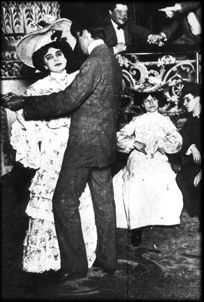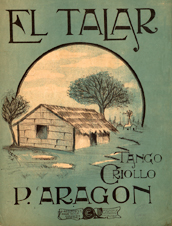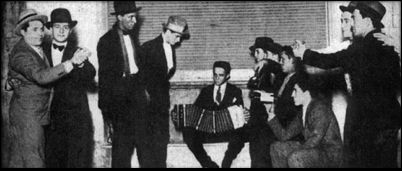By
Reflections about the origins of tango

ango is, in the first place, an essentially danceable musical genre and, as such, it has a beat and a structure that make it different from other musical genres.
 Like any new music, it was influenced by the social and cultural context of the late nineteenth century, which accompanied a part of its evolution.
Like any new music, it was influenced by the social and cultural context of the late nineteenth century, which accompanied a part of its evolution.
Later, those influences shall be disappearing and other musical forms will spring up, to compete for the choice of people, but they shall no longer gravitate in its definitive shaping, which took place between the years 1890 and 1920.
The social frame where primitive tango was born -it is quite difficult to distinguish it as such, as far as beat and structure are concerned- is that of Buenos Aires in 1880, which had a population of 210.000 inhabitants and an important and incipient European immigration. In 1910, due to this phenomenon, the city grows up to 1.200.000 inhabitants and tango reaches its recognizable way. This social process, so peculiar, must not be left aside in our analysis.
We are facing a testimonial resultant, only possible to be understood from an integral vision of our history and our culture.
That incredible cultural fusion of so diverse bloods with our Spanish and native vein made the miracle of expressing itself in a musical and spiritual communion. It is an unprecedented synthesis, which makes of tango a universal and incomparable genre, where the contribution of the Italian component –a great number of Italian immigrants had arrived- is evidenced.
 Buenos Aires in the 1880s was a big village, where there were dance halls (academias) and theaters, the only places where you could dance or watch people dancing during a play. The academias, also called «pirigundines», had hired women and were venues that required a permit issued by the authority to work. They were located in the suburbs and in distant areas far from downtown.
Buenos Aires in the 1880s was a big village, where there were dance halls (academias) and theaters, the only places where you could dance or watch people dancing during a play. The academias, also called «pirigundines», had hired women and were venues that required a permit issued by the authority to work. They were located in the suburbs and in distant areas far from downtown.
In them tango cohabited with other beats like the habanera, the polka, the corrido, the waltz, the schottis and many other airs. There is where it was born and began to develop with that characteristic impulse of popular genres, in a city that grew permanently.
It was usual then that in every comedy, zarzuela (a Spanish operetta) or any other play of the minor genre, the actors would sing and dance. Already before the turn-of-the-century, tango appeared on those shows.
The street barrel organs spread it in different neighborhoods and very often you could see people dancing in the streets, many times men with men. By that time women were scarce, most male immigrants came to try their luck without a couple. Contact with the opposite sex was made at dance halls or in brothels.
Usually we read or hear that tango had its origin in the whorehouses. Nothing is more absurd and incorrect. First, there were no musicians working at brothels. Only at some places in the provinces there were locals that, under the appearance of dance halls, provided the double service and there not only tango was played, but also polkas, milongas, cifras, waltzes and any tune that would cheer the ambience. In Buenos Aires rent was very expensive, there was much demand, so that would have meant a waste of time and money.

The misunderstanding is owed to various reasons. Some dance halls or academias did not have a good reputation and the attendance was varied and, many times, «non sancta». Tough guys and easy living chicks used to go. But that does neither make those places whorehouses nor anything of the sort. Furthermore, people danced not only to tango there.
Also there were prestigious dance halls where people of a higher status used to go and where tango was the king of dances.
Those who adhere to this version are based on the lascivious titles and the connotation implied in some early tangos. Another mistake. That same kind of titles had already been used for polkas and corridos and their lyrics, if any, were repeated, passing from one air to another.
Another constantly spread inexactitude is the one which refers to a banned tango, a tango rejected by the high classes of society.
In 1902 and in following years, the Teatro Opera organized balls including tangos. This was not a place where workers or people from the suburbs used to go.
Furthermore, with the technological improvements the record industry appeared and with it the development of music in general and, especially, tango.
The price of a record was between two pesos and fifty cents and five pesos. A gramophone between 150 and 300 pesos. Sheet music between one peso and three pesos.
Who were then the possible buyers? No doubt, well-to-do people, who besides the machine that played back the record, owned a piano at home to play sheet music. The wage of a policeman at that time was sixty pesos.
Between 1903 and 1910, over a thousand records are released -350 were tango discs- and an incredible number of sheet music. The next decade the output increased to 5500 discs, 2500 were tango tunes. Did the labels release records for not selling them? Were the poor able to buy a gramophone? Who bought records? Who bought written music?
This absurd theory has as its culmination that tango was reinstated by the Buenos Aires society, after its boom in Europe. A new mistake.
The development of tango in Europe began near the end of the second decade of the century, more precisely, after 1912 and blossomed a long time after the period we are talking of.
Finally, the widely proclaimed ban by the Church that was removed thanks to an exhibition before the Pope at the Vatican palace itself.
There is no documented evidence at the Church files. Not even testimonies of the epoch.
The reason of so many nonsense versions has to be found in the lack of a serious research about the origins of tango. Most writers did not work taking this into consideration and accepted as truthful the assertions made by Luis Bates and Héctor Bates, who even though, we have to recognize them as the first ones who wrote about tango, were the parents of many inexactitudes.
 The fundamental book that furnishes a precise and faithful information and which makes use of a scientific system about this issue is titled El tango en la sociedad porteña. 1880-1920, written by Hugo Lamas with the collaboration of Enrique Binda and published by Héctor Lucci. These auteurs think that prejudices and ideological reasons held by the Bates, and other writers that followed them, originated these fallacies about tango.
The fundamental book that furnishes a precise and faithful information and which makes use of a scientific system about this issue is titled El tango en la sociedad porteña. 1880-1920, written by Hugo Lamas with the collaboration of Enrique Binda and published by Héctor Lucci. These auteurs think that prejudices and ideological reasons held by the Bates, and other writers that followed them, originated these fallacies about tango.
In conclusion: tango is a communion of Spanish and native cultures with the one brought by the European immigrant, with strong Italian influence. The milonga, the habanera and the schottis, on one side, and opera music and the canzonetta, on the other, influence its genesis.
It was born in the suburbs, in the outskirts, in the far distant neighborhoods bordering with the countryside. It settled and developed at the dance halls called academias. The street barrel organs spread it through neighborhoods and theaters include it in their plays. It cohabited with other dances but little by little it stood out and conquered downtown.
It was accepted, to a great or lesser extent, by all the social sectors and it was acclaimed in Europe first, and later in the United States and the rest of America.